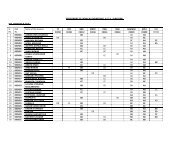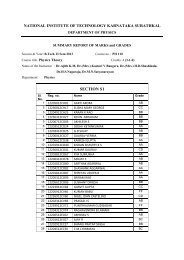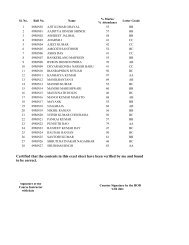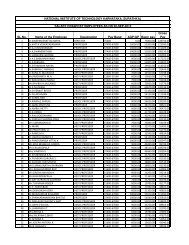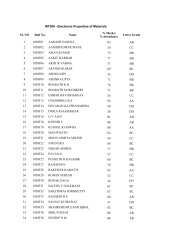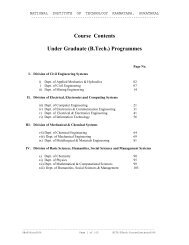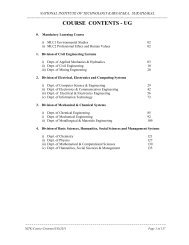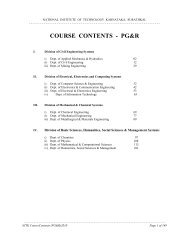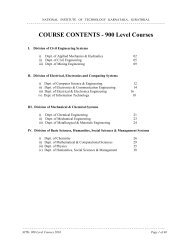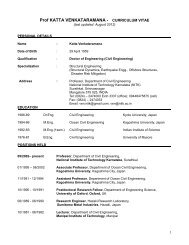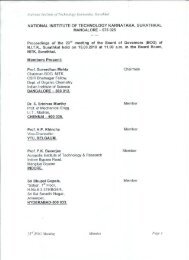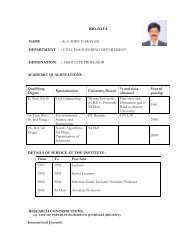course contents - ug - National Institute of Technology Karnataka
course contents - ug - National Institute of Technology Karnataka
course contents - ug - National Institute of Technology Karnataka
You also want an ePaper? Increase the reach of your titles
YUMPU automatically turns print PDFs into web optimized ePapers that Google loves.
NATIONAL INSTITUTE OF TECHNOLOGY KARNATAKA, SURATHAKAL<br />
------------------------------------------------------------------------------------------------------------------<br />
MN404 MINERAL PROCESSING LABORATORY (0-0-3) 2<br />
A total <strong>of</strong> 10 to 12 experiments shall be carried out pertaining to the subject.<br />
MN 411 ROCK FRAGMENTATION ENGINEERING (3-0-0) 3 PREREQ: MN202<br />
Drillability indices. Specific energy. Drilling costs. Determination <strong>of</strong> drill availability and utilization.<br />
Bulk explosive systems. Substitutes for explosives. Blast design. Mechanisms <strong>of</strong> rock fragmentation due<br />
to blasting. Fragmentation prediction and assessment. Theory <strong>of</strong> shaped charges. Recent advances in<br />
blasting techniques in both underground and surface mines. Special techniques <strong>of</strong> blasting. Underwater<br />
blasting. Environmental effects and their control. Controlled blasting techniques. Economic evaluation <strong>of</strong><br />
blasting operations.<br />
Konya, C.G. Blast design.<br />
Persson, Rock fragmentation.<br />
MN412 ROCK SLOPE ENGINEERING (3-0-0) 3<br />
Mechanisms <strong>of</strong> slope failures. Field investigations. Design <strong>of</strong> slopes - physical, empirical, probabilistic<br />
methods, analytical (limit equilibrium analysis) and numerical (continuum models, discontinuum and<br />
crack propagation models) modeling. Stabilization and reinforcement <strong>of</strong> slopes. Slope failure monitoring.<br />
Hoek, E. and Bray, J.W; Rock Slope Engineering; John Wiley & Sons; New York; 1984<br />
Brawner, C.O; Stability in surface mining, SME <strong>of</strong> USA; New York, 1982.<br />
Giani, F; Rock Slope Stability Analysis; Balkema; Rotterdam; 1992.<br />
MN413 NUMERICAL MODELLING TECHNIQUES (3-0-0) 3<br />
Development and use <strong>of</strong> numerical modeling for underground mine design. Finite element (2D and 3D).<br />
Boundary element (2D and 3D). Displacement and continuity. Rigid block. Discrete block models. Basic<br />
equations for mathematical modeling <strong>of</strong> rock mass. Formulation <strong>of</strong> static and dynamic behavior <strong>of</strong> rock<br />
mass. Elastic-linear and non-linear, elastoplastic and time dependent rheological models. Numerical<br />
modeling <strong>of</strong> mine roadways. Convergence prediction for roadways.<br />
Kidybinski A. & Kwasniewski M. (Eds); Modelling <strong>of</strong> Mine Structures, A.A. Balkema, Rotterdam, 1988.<br />
Kidybinski A. & Dubinski J. (Eds); Strata Control in Deep Mines, A.A. Balkema, Rotterdam, 1990.<br />
MN421 MINE ECONOMICS (3-0-0) 3<br />
<strong>National</strong> mineral resources. <strong>National</strong> mineral policy and strategies for development <strong>of</strong> mining industry.<br />
Resource conservation. <strong>Technology</strong> import, taxation, royalty and subsidies. Mineral trade. Concept <strong>of</strong><br />
derivatives in mineral trade. Pricing mechanism <strong>of</strong> minerals. Sampling. Estimation <strong>of</strong> reserves.<br />
Valuation <strong>of</strong> mines and mineral properties, Life <strong>of</strong> a mining project. Project evaluation. Determination <strong>of</strong><br />
optimum size <strong>of</strong> mine. Risk analysis in mineral investment decisions.<br />
Alwyn E. Annels, Mineral Deposit Evaluation: A Practical Approach, Chapman Hall, 1991.<br />
Deshmukh R.T. Mine and Mineral Economics, Emdee Publishers, 1986.<br />
MN425 KNOWLEDGE MANAGEMENT (3-0-0) 3<br />
Concepts, definitions and taxonomy <strong>of</strong> knowledge; value <strong>of</strong> knowledge in an organization. Managing<br />
knowledge in organization: need, drivers(knowledge- based, technology- based; process-based and people<br />
centric); Approaches for managing knowledge in organizations, Developing a KM frame work; KM<br />
system components and implementation strategies; KM models(Boynton and Nonaka);Knowledge<br />
Mapping; Knowledge Architecture;Related applications: Competitive intelligence, Environment<br />
scanning, knowledge/ information Audit, KM metrics and techniques for measuring knowledge; costs and<br />
benefits <strong>of</strong> KM programs in organizations. Role <strong>of</strong> knowledge Managers in an organization; case studies<br />
<strong>of</strong> KM in: sevice firms, core industry, IT firms and others<br />
Sudhir Warier E; Knowledge Management, vikas Publishing Hourse Pvt.Ltd., New Delhi,2003<br />
Archana Shukla and R. Srinivasan, Designing Knowledge Management Architecture: How to implement<br />
successful knowledge Management Programms, Response books, New Delhi, 2002<br />
---------------------------------------------------------------------<br />
NITK-Course Contents(UG)2010 Page 23 <strong>of</strong> 134



